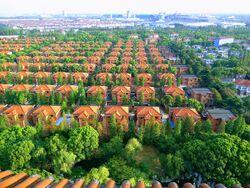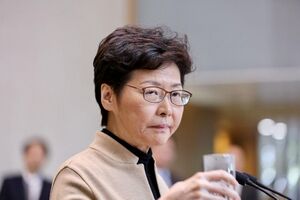Cheun: Difference between revisions
mNo edit summary |
mNo edit summary |
||
| Line 6: | Line 6: | ||
| image_size = | | image_size = | ||
| image_alt = | | image_alt = | ||
| image_caption = Green Villas | | image_caption = Green Villas Residential, an exclusive housing complex for Party members in [[Pianqu]] | ||
| image_flag = Cheun Flag.png | | image_flag = Cheun Flag.png | ||
| image_seal = | | image_seal = | ||
| Line 121: | Line 121: | ||
===Corummese rule=== | ===Corummese rule=== | ||
===Government=== | |||
[[File:Gula.jpg|thumb|President of the Green Villas Residential Homeowners Association and ruler of Cheun, Gula Linlin]] | |||
Originally the governance of Cheunn was regulated by the Cheun Statute in 1938, which was implemented after the end of rule by [[Burgundie]]. The 1938 Statute created a bicameral legislative assembly for the island, the Cheunn Island Council that served for triennial terms and the Advisory Assembly that served four years. Executive authority was vested in the Chief Bureaucratic Officer who was elected every five years from a slate of ten bureaucratic functionaries. | |||
The institutions established by the 1938 statute were replaced in 2007 with the Improved Cheun Statute. The new legislative body is the unicameral Assembly of Homeowners Associations, which as the name implies, gathers all of the registered homeowners associations into a legislative body. The elite Green Villas Residential Association has several built in advantages such as veto power and guaranteed seats in most committees. The new executive was renamed to the Supreme Bureaucratic Officer, and it was stipulated only a resident of Green Villas Residential can be nominated for the post. The current Supreme Bureaucratic Officer is [[Gula Linlin]]. | |||
The Green Villas Residential Homeowners Association and its organs is where most of the island's political hopefuls cut their teeth and gain experience. | |||
==Economy== | ==Economy== | ||
==Transportation== | ==Transportation== | ||
Revision as of 02:29, 8 December 2022
Script error: The module returned a nil value. It is supposed to return an export table.
Cheun Special Federal District 桃籃 | |
|---|---|
Subject of the Democratic Republic of Corumm | |
 Green Villas Residential, an exclusive housing complex for Party members in Pianqu | |
| Special Subject | Corumm |
| Capital and largest city | Pianqu |
| Official languages | Corummese |
| Government | |
• District Chief | San Min |
| Gini (2028) | medium |
| HDI (2068) | medium |
Cheun (Corummese: 桃籃) formerly known as Ayermer is an island territory of the Republic of Corumm. The island is lies just south of the Corummese western coast. Previously a possession of Burgundie, the island was captured by Corummese forces during the Second Great War after a blockade of the island by the Harmonious Flotilla Invincible and a grueling four month siege. All of the population of Levantian descent was expelled from the island after its capture. Nowadays the island and surrounding waters are closed off to foreign tourists. Many medium and high ranking Party and government functionaries have resort homes in Cheun, as a result it has one of the highest per capita incomes by household in the country.
Geography and Climate
History
Original Habitation
Early Modern Period
Main article: Rusana Levantine Exploration
Administered as part of the Ayermer Colony with parts of mainland Rusana from 1616 - ???? by the Ularien Trading Company, which was renamed the Marialanii Ularien Trading Company in 1705. After the Marialanii Ularien Trading Company lost the mainland provinces in the 1800s it maintained the island of Ayermer as a trading post and as a part of La Garrote to control trade and fight piracy in the Puhktun Sea. This primarily impacted Corummese trading traversing westerly.
Later Modern Period
In this period Corumm and Burgundie sparred over the island a number of times with Corumm finally capturing the island in the Second Great War.
Second Great War
Main article: Battle of Ayermer (1936)
Corummese rule
Government

Originally the governance of Cheunn was regulated by the Cheun Statute in 1938, which was implemented after the end of rule by Burgundie. The 1938 Statute created a bicameral legislative assembly for the island, the Cheunn Island Council that served for triennial terms and the Advisory Assembly that served four years. Executive authority was vested in the Chief Bureaucratic Officer who was elected every five years from a slate of ten bureaucratic functionaries.
The institutions established by the 1938 statute were replaced in 2007 with the Improved Cheun Statute. The new legislative body is the unicameral Assembly of Homeowners Associations, which as the name implies, gathers all of the registered homeowners associations into a legislative body. The elite Green Villas Residential Association has several built in advantages such as veto power and guaranteed seats in most committees. The new executive was renamed to the Supreme Bureaucratic Officer, and it was stipulated only a resident of Green Villas Residential can be nominated for the post. The current Supreme Bureaucratic Officer is Gula Linlin.
The Green Villas Residential Homeowners Association and its organs is where most of the island's political hopefuls cut their teeth and gain experience.
